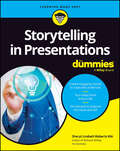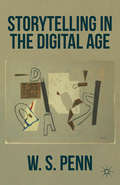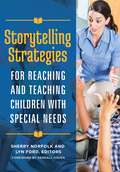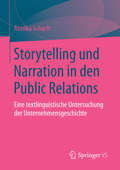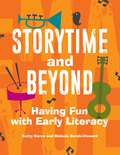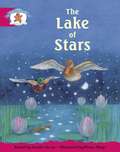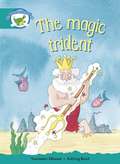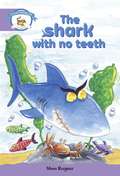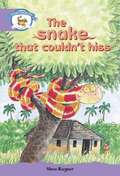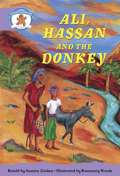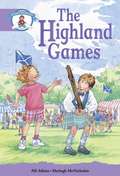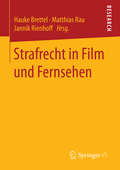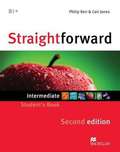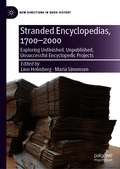- Table View
- List View
Storytelling in Northern Zambia: Theory, Method, Practice and Other Necessary Fictions (World Oral Literature Series #3)
by Robert CancelMore than just a book, Storytelling in Northern Zambia lets you watch videos of the storytellers while you read. Storytelling plays an important part in the vibrant cultural life of Zambia and in many other communities across Africa. This innovative book provides a collection and analysis of oral narrative traditions as practiced by five Bemba-speaking ethnic groups in Zambia. The integration of newly digitalised audio and video recordings into the text enables the reader to encounter the storytellers themselves and hear their narratives as they were recounted during Robert Cancel’s research trips to Zambia. Robert Cancel's thorough critical interpretation, combined with these newly digitalised audio and video materials, makes Storytelling in Northern Zambia a much needed addition to the slender corpus of African folklore studies that deal with storytelling performance. Cancel threads his way between the complex demands of African fieldwork studies, folklore theory, narrative modes, reflexive description and simple documentation and succeeds in bringing to the reader a set of performers and their performances that are vivid, varied and instructive. He illustrates this living narrative tradition with a wide range of examples, and highlights the social status of narrators and the complex local identities that are at play. Cancel’s innovative study tells us not only about storytelling but sheds light on the study of oral literatures throughout Africa and beyond. Its innovative format, meanwhile, explores new directions in the integration of primary source material into scholarly texts. This book is part of our World Oral Literature Series in conjunction with the World Oral Literature Project.
Storytelling in Presentations For Dummies
by Sheryl Lindsell-RobertsLearn to influence audiences with storyopia: Stories that take them on a journey from what is to what could be: Storytelling in Presentations For Dummies shows you how to develop and deliver a presentation through storytelling, keeping audience interested, and most importantly, making them heroes that take action towards change. You’ll learn how to cull stories from your own experiences, and before you know it, you’ll have more stories than Aesop has fables. You’ll learn about the latest presentation software, so you can integrate visuals into your presentations and avoid the dreaded “Death by PowerPoint.” You’ll also learn how to deal with challenging on-the-spot situations, deliver investor pitches and executive briefs, and present a paper at a conference. Additionally, find out how to deliver someone else’s content and make it your own. This book will help you level up anywhere you need to present information by mastering the art of savvy presentations—the most effective business communications tools of our time. Identify experiences that can be molded into stories that drive change. Prepare powerful openings to hook your audience right away whether delivering in person, online, or hybrid Have your audience get the most from your presentation with an effective call to action Prepare a storyboard, which is like a frame-by-frame roadmap, that will mesh together what you’ll show and what you’ll tell Leverage software like Canva, Prezi, and Storyboarder to tie your presentation together Enjoy the colorful 8-page mini-booklet, “Storytelling to Storyboarding”This Dummies guide is perfect for any professional who needs to present, and at some time all professionals do. It’s also for entrepreneurs who want to build community and grow their business, in addition to students who want to wow teachers and classmates.
Storytelling in Presentations For Dummies
by Sheryl Lindsell-RobertsLearn to influence audiences with storyopia: Stories that take them on a journey from what is to what could be: Storytelling in Presentations For Dummies shows you how to develop and deliver a presentation through storytelling, keeping audience interested, and most importantly, making them heroes that take action towards change. You’ll learn how to cull stories from your own experiences, and before you know it, you’ll have more stories than Aesop has fables. You’ll learn about the latest presentation software, so you can integrate visuals into your presentations and avoid the dreaded “Death by PowerPoint.” You’ll also learn how to deal with challenging on-the-spot situations, deliver investor pitches and executive briefs, and present a paper at a conference. Additionally, find out how to deliver someone else’s content and make it your own. This book will help you level up anywhere you need to present information by mastering the art of savvy presentations—the most effective business communications tools of our time. Identify experiences that can be molded into stories that drive change. Prepare powerful openings to hook your audience right away whether delivering in person, online, or hybrid Have your audience get the most from your presentation with an effective call to action Prepare a storyboard, which is like a frame-by-frame roadmap, that will mesh together what you’ll show and what you’ll tell Leverage software like Canva, Prezi, and Storyboarder to tie your presentation together Enjoy the colorful 8-page mini-booklet, “Storytelling to Storyboarding”This Dummies guide is perfect for any professional who needs to present, and at some time all professionals do. It’s also for entrepreneurs who want to build community and grow their business, in addition to students who want to wow teachers and classmates.
Storytelling in Radio and Podcasts: A Practical Guide
by Sven PregerThis textbook offers a practical guide to creating narratives in audio media. It is one of the most beautiful and complex tasks in radio and podcasting: how do you tell a compelling story and keep your listeners tuned in? In Storytelling in Radio and Podcasts, Preger offers practical answers to crucial questions: What material is suitable for long stories? How can I bind listeners to a real story for 15, 30 or 60 minutes? Or even get them excited about a whole series? How do I maintain suspense from beginning to end? How do I find my narrative voice? And, how do I develop a sound design for complex narratives? Richly illustrated using practical examples, the book guides the reader through various stages of developing a non-fiction narrative and examines structure, character development, suspense, narration, sound-design and ethics.
Storytelling in the Classroom: Enhancing Traditional Oral Skills for Teachers and Pupils (PDF)
by Alison Davies`Too afraid to have a go at oral storytelling in the classroom? This is the book for you!...The book guides you through choosing a tale you really enjoy, knowing your audience and not being afraid to adapt a tried and tested fairy tale' - Literacy Time `This book is ideal for all adults working with children (mainly at primary level) and would be especially useful for those less confident or who are new to their role. It provides a great opportunity to practise an inspirational and creative approach to teaching and learning...I really enjoyed this book and took away much to think about' - Ruth Underwood, primary inclusion co-ordinator `The ability level for this book is aimed at teachers teaching ages 5-11 and I'd say the author has it spot on. As an educational resource I rate this book highly and think it is a valuable read for all primary teachers. It helps you to think of how you can use storytelling as a tool in ways you won't have thought of before. It's a very enjoyable read and if you're pushed for time you can just dip into the parts you want. I definitely recommend it' - TES website Drawing on her experience as a professional storyteller, in this book, Alison Davies show teachers how to develop storytelling skills as part of a new engaging approach to creative teaching and learning. Packed with hands on, practical advice, the book also includes a range of stories for teachers to use in different class situations. The stories are in an easy to learn format, with pointers and tips on how to tell them and how to involve the class. Topics covered include: - bullying - disabilities - computer games - friendship - greed There are also lots of lesson plans with ideas for starters, mains and plenary sessions, and tips on developing creativity and presentation of ideas in an engaging manner to suit any topic or situation across the curriculum. As well as giving the reader the opportunity to practice their new skills and giving them the confidence to develop their own stories, the activities help them to develop these skills in young people. The book is ideal for teachers, teaching assistants, youth club workers-anyone in a primary level setting who has the opportunity to develop storytelling as a creative and inspirational experience. Alison Davies has also edited Shrouded in Darkness: Tales of Terror to raise money for DebRA, a national charity working on behalf of people with the genetic skin blistering condition, Epidermolysis Bullosa (EB). The book features contributions from from Neil Gaiman, Clive Barker, Christopher Fowler, Simon Clark and Graham Masterton. All royalties from this book will go to the charity to help them continue their good work. Please click on this link to view details of this book.
Storytelling in the Digital Age
by W. PennThrough a professional story-teller's sometimes humorous commentary on culture and literature from The Odyssey on , the book suggests that literature is not an artifact to be studied but a living process. Often irreverent, crossing literary and scholarly lines, Penn aims to discover what literature does for an imaginatively engaged reader.
Storytelling Strategies for Reaching and Teaching Children with Special Needs
by Sherry Norfolk Lyn FordThis book supplies stories, essays, lesson plans and specialized storytelling strategies to help teachers "level the playing field" for all learners and better serve children with special needs.More than 57 percent of the over 6 million American children with disabilities are in inclusive (i.e., general) classrooms; "self-contained" classrooms serve children whose disabilities are either more severe or disruptive. As much as 20 percent of the children in an inclusive classroom are identified as "disabled," with the highest percentage of these having learning disabilities. While most classrooms have at least one child with a disability, teachers often have little or no training in educating and caring for these children. The need for resources that support educators working with children with disabilities or social/emotional difficulties is clear. This book fills this critical need, supplying school and public librarians, classroom and special area teachers, and storytelling teaching artists with storytelling strategies for reaching and teaching children with special needs in inclusive classrooms, self-contained classrooms, and public and school libraries. These full-text stories, essays, and lesson plans from experienced storytelling teaching artists provide educators with a wide range of adaptable storytelling and teaching strategies for specific disabilities and enable storytellers to discover news ways to perform their storytelling magic. The book also offers compelling real-life anecdotes that demonstrate the impact of these strategies in inclusive and self-contained classrooms; presents an introduction to the skills of storytelling, why they are useful, and how to use them; and includes suggested modifications for a wide range of disabilities as well as detailed resource lists.
Storytelling Strategies for Reaching and Teaching Children with Special Needs
by Sherry Norfolk and Lyn FordThis book supplies stories, essays, lesson plans and specialized storytelling strategies to help teachers "level the playing field" for all learners and better serve children with special needs.More than 57 percent of the over 6 million American children with disabilities are in inclusive (i.e., general) classrooms; "self-contained" classrooms serve children whose disabilities are either more severe or disruptive. As much as 20 percent of the children in an inclusive classroom are identified as "disabled," with the highest percentage of these having learning disabilities. While most classrooms have at least one child with a disability, teachers often have little or no training in educating and caring for these children. The need for resources that support educators working with children with disabilities or social/emotional difficulties is clear. This book fills this critical need, supplying school and public librarians, classroom and special area teachers, and storytelling teaching artists with storytelling strategies for reaching and teaching children with special needs in inclusive classrooms, self-contained classrooms, and public and school libraries. These full-text stories, essays, and lesson plans from experienced storytelling teaching artists provide educators with a wide range of adaptable storytelling and teaching strategies for specific disabilities and enable storytellers to discover news ways to perform their storytelling magic. The book also offers compelling real-life anecdotes that demonstrate the impact of these strategies in inclusive and self-contained classrooms; presents an introduction to the skills of storytelling, why they are useful, and how to use them; and includes suggested modifications for a wide range of disabilities as well as detailed resource lists.
Storytelling und Narration in den Public Relations: Eine textlinguistische Untersuchung der Unternehmensgeschichte
by Annika SchachDas Buch präsentiert eine textlinguistische Analyse von Texten zur Unternehmensgeschichte und widmet sich dem vielzitierten Storytelling-Trend. Anhand von Textexemplaren der DAX30-Unternehmen werden die Textfunktion, Themenentfaltung und Formulierungsspezifika untersucht. Ein besonderer Schwerpunkt liegt in der Fragestellung, inwieweit Narration als Vertextungsstrategie verwendet wird und wie sich die Textexemplare in einer Typologie beschreiben lassen. Die Arbeit stellt zudem einen Bezug zum medienwissenschaftlichen Framing-Ansatz her.
Storytime and Beyond: Having Fun with Early Literacy
by Kathy Barco Melanie Borski-HowardJoin the world of balloons, pancakes, and musical instruments—just a few items to help improve early literacy in the library, the classroom, and at home. Literacy-builders covered range from music and instruments to magnetic letters, alphabet beads, and food.Literacy is a popular topic of discussion among librarians. Especially important is "early literacy," what children know about reading and writing before they can actually read and write. In this book, experienced librarians Kathy Barco and Melanie Borski-Howard share hands-on techniques that they have used to successfully promote early literacy and encourage family involvement. Storytime and Beyond teaches readers how to use "literacy doodads"—inexpensive props that add excitement to storytimes and can be used outside the library or classroom—to enhance the basic components of any early literacy program: talking, singing, reading, writing, and playing. Many of the doodads can be created as family do-it-yourself projects, and some can be adapted to work with non-readers of any age. Instruments can also be a great way to get children's attention and teach literacy skills, whether it's a drum to beat while reading a story or a maraca for children to shake during a song, and lesson plans for musical storytimes address how to use rhythm, singing, and dancing to make early literacy fun.
Storytime and Beyond: Having Fun with Early Literacy
by Kathy Barco Melanie Borski-HowardJoin the world of balloons, pancakes, and musical instruments—just a few items to help improve early literacy in the library, the classroom, and at home. Literacy-builders covered range from music and instruments to magnetic letters, alphabet beads, and food.Literacy is a popular topic of discussion among librarians. Especially important is "early literacy," what children know about reading and writing before they can actually read and write. In this book, experienced librarians Kathy Barco and Melanie Borski-Howard share hands-on techniques that they have used to successfully promote early literacy and encourage family involvement. Storytime and Beyond teaches readers how to use "literacy doodads"—inexpensive props that add excitement to storytimes and can be used outside the library or classroom—to enhance the basic components of any early literacy program: talking, singing, reading, writing, and playing. Many of the doodads can be created as family do-it-yourself projects, and some can be adapted to work with non-readers of any age. Instruments can also be a great way to get children's attention and teach literacy skills, whether it's a drum to beat while reading a story or a maraca for children to shake during a song, and lesson plans for musical storytimes address how to use rhythm, singing, and dancing to make early literacy fun.
Storyworlds, Stage 5, Once Upon A Time World: The Lake of Stars
by Jamila GavinMother Duck looked up at the stars. Then she looked down at the flowers. 'They are not flowers,' she said. 'We can see the stars in the water.' This fantastic range of fiction for Shared, Guided and Independent reading gives you stories your children will love to read over and over again.
Storyworlds, Stage 6, Fantasy World: The Magic Trident
by Narinder DhamiDown, down, down under the sea was a magic kingdom. The King of the Sea lived there. He had a magic trident and when he blew on It he could do magic. This fantastic range of fiction for Shared, Guided and Independent reading gives you stories your children will love to read over and over again.
Storyworlds, Stage 8, Animal World: The shark with no teeth
by Shoo RaynerWe all know that sharks have lots of big teeth. Well, this is a story about a shark that lost his teeth. The shark was called Cruncher. This fantastic range of fiction for Shared, Guided and Independent reading gives you stories your children will love to read over and over again. The stories presented in Stage 8 are more complex than those in the earlier stages of the series, introducing a range of genres and grammatical features.
Storyworlds, Stage 8, Animal World: The snake that couldn't hiss
by Shoo RaynerWe all know that snakes hiss. Well, this is a story about a snake that could not hiss. The snake was called Sneaker. This fantastic range of fiction for Shared, Guided and Independent reading gives you stories your children will love to read over and over again. The stories presented in Stage 8 are more complex than those in the earlier stages of the series, introducing a range of genres and grammatical features.
Storyworlds, Stage 8, Once Upon A Time World: Ali, Hassan and the Donkey
by Samira Zaidan"Ali and Hassan worked very hard on their farm. They had a grey donkey who helped them to do their work."This fantastic range of fiction for Shared, Guided and Independent reading gives you stories your children will love to read over and over again. Gaelic and Scottish teaching support also accompanies this reading series.
Storyworlds, Stage 8, Once Upon A Time World: Ali, Hassan and the Donkey (PDF)
by Samira Zaidan"Ali and Hassan worked very hard on their farm. They had a grey donkey who helped them to do their work."This fantastic range of fiction for Shared, Guided and Independent reading gives you stories your children will love to read over and over again. Gaelic and Scottish teaching support also accompanies this reading series.
Storyworlds, Stage 8, Our World: The Highland Games
by Jill AtkinsIn the summer Alison went to stay with her gran and grandad in Scotland. A boy called Jamie lived next door to them. One day Alison and Grandad were going to the Highland Games. This fantastic range of fiction for Shared, Guided and Independent reading gives you stories your children will love to read over and over again. The stories presented in Stage 8 are more complex than those in the earlier stages of the series, introducing a range of genres and grammatical features.
Strafrecht Allgemeiner Teil: Personale Straftatlehre (Springer-Lehrbuch)
by Georg FreundDas kompakte Lehrbuch basiert auf einem innovativen Grundkonzept der Lehre von der Straftat. Ausgehend von einem tatbestandsspezifischen Fehlverhalten werden die Voraussetzungen des Strafrechts schrittweise entwickelt. Das Werk erfasst den examensrelevanten Stoff der Lehre von der Straftat und ist für eine vertiefte Auseinandersetzung und die Examensvorbereitung gleichermaßen geeignet. Als zusätzliche Hilfestellung enthält die Neuauflage griffige Definitionen, klare Schemata und weitere sorgfältig ausgewählte Fälle.
Strafrecht Allgemeiner Teil (Springer-Lehrbuch)
by Walter GroppStrafrecht gehört zu den am klarsten strukturierten Rechtsgebieten, besonders der Allgemeine Teil. Das Lehrbuch arbeitet die tragenden Elemente dieser Struktur heraus und zeigt die Querverbindungen auf. Klar, übersichtlich und lerngerecht wird der Aufbau der Straftat erklärt. Leitfälle und zahlreiche Beispiele geben auch dem Studienanfänger schnelle Orientierung und erleichtern den Einstieg in weiterführende Literatur. Kontrollfragen ermöglichen die Überprüfung des Lernerfolgs.
Strafrecht in Film und Fernsehen
by Hauke Brettel Matthias Rau Jannik RienhoffDieser Band widmet sich aktuellen Fragen zur Darstellung von Recht und Gerechtigkeit in Filmen und Serien und den transportierten Inhalten oder den Auswirkungen der Mediendarstellungen auf die RezipientInnen bzw. den Wechselwirkungen mit Kriminaljustiz und -politik. Schwerpunkte bilden Ausführungen zur Darstellung von fiktiver und realer Kriminalität im Fernsehen sowie zu bekannten Krimiserien wie „Tatort“ oder „CSI“. Zudem werden populäre Spielfilme wie „Minority Report“ oder SuperheldInnen-Verfilmungen einer kriminologischen Analyse unterzogen. Hierbei eröffnen sich zahlreiche Diskurse über Recht und Gerechtigkeit, um ihren Zusammenhang und ihre Widersprüche, die (nicht nur) in den Medien- und Rechtswissenschaften geführt werden.
Straight Acting: The Many Queer Lives of William Shakespeare
by Will Tosh'Engrossing, enlightening and hugely entertaining'SARAH WATERS, author of Fingersmith'Brilliant - so vivid and so sharp, fantastically clever and consistently fascinating'KATHERINE RUNDELL, author of Super-InfiniteWas Shakespeare gay? The answer is both simpler and more complex than you might think . . .Shakespeare's work was profoundly influenced by the queer culture of his time - much of it totally integrated into mainstream society. From a relentless schooling in Latin and Greek homoeroticism, to a less formal education on the streets and in smoky taverns, from the gender-bending of the early comedies to the astonishingly queer literary scene that nurtured Shakespeare's sonnets, this is a story of artistic development and of personal crisis.Straight Acting is a surprising portrait of Shakespeare's queer lives - his own and those in his plays and poems. It is a journey back in time and through Shakespeare's England, revealing a culture that both endorsed and supressed same-sex desire. It is a call to stop making Shakespeare act straight and to recognise how queerness powerfully shaped the life and career of the world's most famous playwright.'Magisterial and saucy . . . This fresh account kickstarts the queer canon of English literature: Shakespeare won't go back in the closet again'EMMA SMITH, author of This Is Shakespeare
Straight and Crooked Thinking (Teach Yourself)
by Robert Henry ThoulessThis new edition of a timeless classic demonstrates how the use of clear, rational thinking and logic can win any argument, however emotionally charged the topic in question. It describes the typical flaws of reasoning in argument and shows how language can be used to deceive - and how to avoid being deceived. It will show you how, by learning what is 'straight', rational language, and clear thought, you can disentangle emotionally charged rhetoric and hold your own in any argument or debate, no matter how challenging. Although written nearly 80 years ago, this book proves that certain principles remain timeless; it has shown many thousands over the decades how to cope with media spin and distorted reasoning - and now it will do the same for you.
Straightforward: Intermediate Student's Book (2nd Edition) (PDF)
by Philip Kerr Ceri JonesA general English course for adults and young adults based on observation of what good teachers do in the classroom. The lessons offer a balanced mix of language input, skills work and oral tasks.
Stranded Encyclopedias, 1700–2000: Exploring Unfinished, Unpublished, Unsuccessful Encyclopedic Projects (New Directions in Book History)
by Linn Holmberg Maria SimonsenIn Stranded Encyclopedias, 1700–2000: Exploring Unfinished, Unpublished, Unsuccessful Encyclopedic Projects, fourteen scholars turn to the archives to challenge the way the history of modern encyclopedism has long been told. Rather than emphasizing successful publications and famous compilers, they explore encyclopedic enterprises that somehow failed. With a combined attention to script, print, and digital cultures, the volume highlights the many challenges facing those who have pursued complete knowledge in the past three hundred years. By introducing the concepts of stranded and strandedness, it also provides an analytical framework for approaching aspects often overlooked in histories of encyclopedias, books, and learning: the unpublished, the unfinished, the incomplete, the unsuccessfully disseminated, and the no-longer-updated. By examining these aspects in a new and original way, this book will be of value to anyone interested in the history of encyclopedism and lexicography, the history of knowledge, language, and ideas, and the history of books, writing, translating, and publishing. Chapters 1 and 4 are available open access under a Creative Commons Attribution 4.0 International License via link.springer.com.

